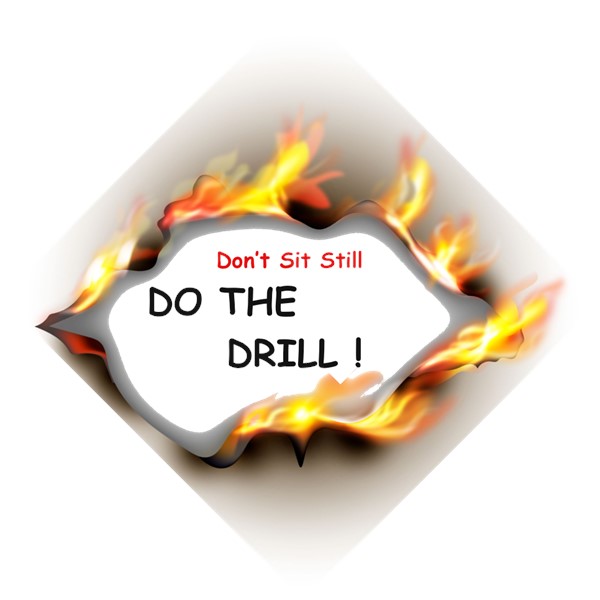
Never underestimate the importance of safety drills
Knowing emergency procedures and drills are critical to safety in the workplace and for your patients. Performing drills can help in the following ways:
- You can ensure that alarms/equipment are working properly.
- Everybody knows their roles and responsibilities, and become confident with how to respond to an emergency.
- You can validate that your emergency procedures are effective or identify areas that need improvement.
Emergency Procedures and Safety Drills
The NFPA 99 2012 edition, chapter 14 contains codes related to emergency procedures to help clarify the original intent of conducting safety drills. There are many emergency scenarios that hyperbaric staff should be prepared to respond to. NFPA 99 states we should perform and document all emergency procedures and fire training drills.
Examples of these are:
- Fire in the chamber (with a timed egress of all the staff)
- Fire in the hyperbaric oxygen therapy (HBO) department
- Fire in the hospital
- Loss of oxygen in the chamber
- Pneumothorax in the chamber
- Cardiac arrest in the chamber
- Seizure in the chamber
- Loss of power to the facility
- Communication loss in the chamber
- Chamber door safety pin jam
- Prohibited item(s) authorization process (See Go-No-Go Lists / Prohibited Items)
Practice Makes Perfect
All scenarios require training if and when the time comes, so all staff are confident in how to respond appropriately. We can come up with plenty of examples to support why conducting at least one safety drill each month is a good idea. Doing so will ensure that by the end of each year we have met the NFPA code requirement. Every staff member, including physicians, should be formally trained on these items upon initial orientation to working in the department.
Fire Drill with Timed Egress
A timed fire egress should be performed at least once a year with a realistic worst-case scenario. If you have three class B chambers, all three should be compressed to 3 ATA with simulated non-ambulatory patients. One chamber might be on fire in the scenario. Smoke hoods should be utilized in the simulation for the total number of staff participants in the drill. The entire time of egress should not exceed the maximum lifetime of the charcoal filter in the smoke hood. If it does, then you need a better smoke hood.
All the patients and staff should be evacuated to the nearest fire safe location as established by the hospital and posted on the evacuation map in the HBO suite. Staff members should apply all aspects RACE (Rescue, Alarm, Confine, Extinguish) in this drill and simulate using the fire extinguisher using PASS (Pull, Aim, Squeeze, Sweep).
Annex B of NFPA 99 14.2 and 14.3 describe the procedure.
- B.14.2. Suggested Procedures to Follow in Event of Fire in Class A Chambers.
- B.14.3. Suggested Procedures for Hyperbaric Chamber Operator to Follow in Event of Fire in Class B Chambers.
It is important to understand that if you shut off the oxygen for the monoplace chamber at the wall valve you disable the emergency decompression vent function resulting in the chamber decompressing at a much slower rate, similar to a ‘loss of oxygen’ scenario. For those chambers, turn off the oxygen after each chamber reaches the surface. Additionally, shut off the hyperbaric oxygen zone valve outside the department doors upon evacuation.
During the emergency evacuation drill, fire pull stations should be activated, (simulated) patients should be communicated with a calm and clear manner, electric devices in the vicinity unplugged, additional patients in the vicinity should be rescued and evacuated by wheelchair or gurney or ambulate as appropriate.
NFPA wants to ensure we know that smoke hood will be effective for the duration of time while we are applying RACE in the smoke-filled chamber suite. The Draeger Parat Smoke Hood has a 15-minute charcoal filter life. During this interval, staff may face several types of situations. Discuss and plan how to manage an HBO patient with any of the following: negative pressure wound therapy (NPWT), fever, implantable medication pump, defibrillator or pacemaker, external pacemaker, vaseline gauze dressing, hearing aide, medication patch, diaper, Kotex, Thermacare warmer, On-Q pain pump ball, Compression therapy devices (e.g., Unna boot, Coban dressing), silver dressing, external fixator, non-gas permeable contact lens, loose fillings, dentures, synthetic hair, pressure ulcers on the coccyx, wedding band unable to be removed, upper respiratory infection, Teed scores >2, anxiety, claustrophobia, steroid use or seizure disorder.
All of these factors create a realistic setting and will increase the time for the evacuation. A formal report should be written by the safety director for every safety drill and presented for discussion with all staff. This document should be used as a reference for future drills and kept on file with the department and available to the hospital. Safety training cannot be emphasized enough in the hyperbaric chamber setting. Ensuring that all staff and physicians involved in the program are competent in these procedures is the responsibility of the Hyperbaric Safety Director.
Posting emergency procedures at each chamber and frequently referencing the chamber operations manual will serve to ensure that each step is followed and all variables/limitations that might occur are addressed.
Some limitations are not apparent until a drill is actually conducted with all parties present.
Should a limitation be identified the team should brainstorm about the situation and come up with potential solutions.

Keep On Your Radar
2012 NFPA 99 codes related to safety drills:
14.2.4.5– Emergency Decompression and Facility Evacuation Capability
- 14.2.4.5.3 - A source of breathable gas allowing unrestricted mobility shall be available outside a Class A or Class B chamber for use by personnel in the event that the air in the vicinity of the chamber is fouled by smoke or other combustion products of fire.
- 14.2.4.5.3 A - The intent of this requirement is to allow facility staff to evacuate the facility and avoid breathing contaminated air. This requirement is permitted to be met using either a self-contained breathing apparatus, smoke hood with integral filter/air supply, or similar technology.
- The number of units available should be adequate to meet facility staffing.
- The breathing duration of the personal protection devices should be predicated upon the time necessary for evacuation of the facility.
- Facility evacuation time should be determined during fire drills conducted by the hyperbaric facility.
- 14.2.4.5.4 - The time required to evacuate all persons from a hyperbaric area with a full complement of chamber occupants all at treatment pressure shall be measured annually during the fire training drill required by 14.3.1.4.5.
- 14.2.4.5.4.1 - The occupants for this training drill shall be permitted to be simulated.
14.3.1.4.3 - All personnel, including those involved in maintenance and repair of the hyperbaric facility, shall be trained on the purpose, application, operation, and limitations of emergency equipment.
- 14.3.1.4.4 - Emergency procedures specific to the hyperbaric facility shall be established.
- 14.3.1.4.4.1 A - The administrative, technical, and professional staffs shall jointly develop policies for management of the hyperbaric facility.
- 14.3.1.4.4.2 - Personnel shall be trained to control the chamber and decompress occupants when all powered equipment has been rendered inoperative.
- 14.3.1.4.5 - Emergency procedures and fire training drills shall be conducted at least annually and documented by the Safety Director.
- 14.3.1.4.5 A - A calm reaction (without panic) to an emergency situation can be expected only if the recommendations are familiar to and rehearsed by all concerned. A suggested outline for emergency action in the case of fire is contained in B.14.2 (Annex B of NFPA 99 2012 Edition).
Resources
The WoundReference Hyberbaric Oxygen Therapy Knowledge Base features guidelines to promote high standards of patient care and operational safety within the hyperbaric program and other important tools. The WoundReference Curbside Consult gives you actionable, specific answers from our expert panel in a timely manner.
For customized safety programs and other wound care and hyperbaric medicine consultation services, visit MidWest Hyperbaric.
Acknowledgement
We thank Julie Rhee ScM, for style editing
About the Authors
Jeff Mize, RRT, CHT, UHMSADS
With over four decades of healthcare experience, Jeff currently holds the position of Principal Partner at Midwest Hyperbaric LLC and the Co-founder and Chief Clinical Officer of Wound Reference.
Jeff has excelled in critical care throughout his career, devoting almost a decade as a Flight Respiratory Therapist/Paramedic for the Spirit of Kansas City Life Flight. In 1993, Jeff transitioned into the field of Hyperbaric Medicine and Wound Care, where he committed 21 years of his career to serving as the Program Director for a 24/7 Level 1 UHMS Accredited facility with Distinction. In this role, he continued to provide patient care while overseeing all administrative, clinical, and daily operations within the Wound Care and Hyperbaric Facility.
Jeff is a Registered Respiratory Therapist and a Certified Hyperbaric Technologist (CHT). He has also undergone training as a UHMS Safety Director and a UHMS Facility Accreditation Surveyor.
Jeff currently serves as a member of the UHMS Accreditation Council, the UHMS Accreditation Forum Expert Panel, and the UHMS Safety Committee. Additionally, he is an esteemed member of the NFPA 99 Hyperbaric and Hypobaric Facilities Technical Standards Committee.
Jeff's dedication to the field has earned him numerous prestigious awards. In 2010, he received the Gurnee Award, which honored his outstanding contributions to undersea and hyperbaric medicine. Three years later, in 2013, he was awarded the Paul C. Baker Award for his commitment to Hyperbaric Oxygen Safety Excellence. Most recently, in 2020, Jeff was honored with "The Associates Distinguished Service Award (UHMSADS)," a recognition reserved for exceptional Associate members of the Society who have demonstrated exceptional professionalism and contributions deserving of the highest accolades.
Tiffany Hamm, BSN, RN, CWS, ACHRN, UHMSADS
An Advanced Certified Hyperbaric Registered Nurse and Certified Wound Specialist with expertise in billing, coding and reimbursement specific to hyperbaric medicine and wound care services. UHMS Accreditation Surveyor and Safety Director. Principal partner of Midwest Hyperbaric LLC, a hyperbaric and wound consultative service. Tiffany received her primary and advanced hyperbaric training through National Baromedical Services in Columbia South Carolina. In 2021, Tiffany received the UHMS Associate Distinguished Service Award. "This award is presented to individual Associate member of the Society whose professional activities and standing are deemed to be exceptional and deserving of the highest recognition we can bestow upon them . . . who have demonstrated devotion and significant time and effort to the administrative, clinical, mechanical, physiological, safety, technical practice, and/or advancement of the hyperbaric community while achieving the highest level of expertise in their respective field. . . demonstrating the professionalism and ethical standards embodied in this recognition and in the UHMS mission.”